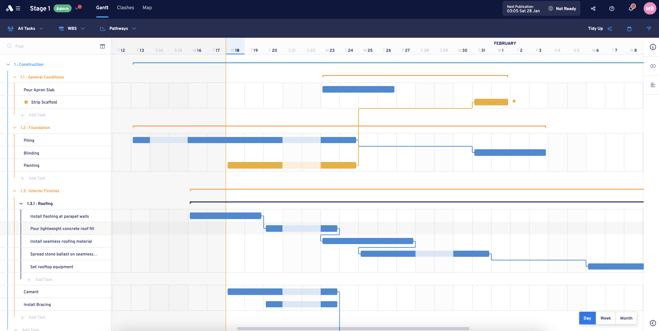If you’re responsible for managing short-term plans or, you’re on the delivery team, you’ll be all too familiar with how quickly things can feel like they’re getting out of hand.
One minute the project feels like it’s going well, and the next, you’re overspent and delays seem to be spiralling out of control.
The good news is that there are theoretical tools and practices (like milestone planning) to help you prevent unexpected issues from disrupting the project.
What are milestones in construction?
Milestones are a planning management tool used to highlight key dates and activities in your construction schedule.
They are usually used to signify the start and end of a project, along with the completion or handover of any major phases of work. This helps summarise and track more detailed schedules and makes it easier to estimate the time and resources needed to complete a project.
The most common milestones you’ll likely come across in construction are: start dates, end dates, sectional completion dates and project handover dates.
Sectional completion dates
- The specific date that a section of work is set to be completed.
Handover dates
- The agreed date that a work area is set to be passed from one team or subbie to another.
By building milestones into your plans, you give yourself regular opportunities to review the quality of completed works, assess your budget, and track delays. This way, you can make informed decisions before moving on with your project and prevent issues that could lead to project failure.
Why construction projects fail
According to McKinsey, 98% of construction megaprojects incur cost overruns or delays. The average slippage is 20 months behind schedule, and the average cost comes in at 80% over the original value.
Those numbers are wild.
The problem is that there is no ‘one’ culprit. Some sites suffer from a communication breakdown; others have poor planning or a lack of reporting procedures. There’s a wide range of reasons why projects might fail, but that doesn’t mean all hope is lost.
By putting procedures like milestones in place, you can identify where you need to improve productivity to help keep your project out of the red.

Why are project milestones important?
Milestones define key dates and activities in your schedule. This makes the project easier to analyse and gives you a better picture of what is going well and what isn’t. It also makes it easier to track variance and causes for delays before they compound into more significant issues.
Not only that, but milestones can help break large projects down into more manageable chunks. In the same way that tasks are used to break down individual projects, milestones can be used to break down project phases.
Below are some of the most beneficial ways you can use milestones.
Monitor progress and deliverables
One of the main reasons to use milestones is to track progress. Use this as an opportunity to benchmark production rates, calculate costs vs budget, and give your project a health check.
Often, issues and delays aren’t flagged on a project until they’ve already impacted the critical path, or you find yourself massively overspent. But by checking in at periodic intervals, you can try and stay on top of things before they get out of hand.
Highlight key dates
This may come across as an obvious one, but milestones are a great way of pointing out important dates and turn points in your project. That includes things like start dates, end dates and handover dates. But it might also include such things as:
- Permit expiry dates
- Halfway markers
- Annual reporting dates
And any other point in your plan that you might want to stop to assess the situation.

Track variance and delay
By tracking variance and delay at smaller intervals throughout the life of a project, you can calculate the overall impact on the critical path. With this information, you can then make more informed decisions about any corrective actions that may need to be taken.
There are a variety of ways to calculate variance, from dashboards to spreadsheets, but it’s a simple calculation. All you need to know is your key dates (as signified by the milestone) and the number of days you are ahead or behind schedule.
Identify issues and bottlenecks
More often than not, delays and other site issues are the results of recurring themes or a broken process.
There are a lot of moving parts on-site, and as well as planning for your own team, you also need to consider the planning of other teams and third parties like suppliers and subbies.
If you find yourself in a position where there are frequent issues with your project, or you come to a milestone and realise you’re behind schedule; take that as a sign that you need to dig a little deeper into the issues your team is facing.
This can often be resolved by regularly carrying out root cause analysis and identifying recurring issues contributing to delays.
Milestone planning
When planning your milestones, there are no hard, fast rules; in theory, you can plan as many milestones as you’d like. But, there are a few common sense principles you should follow.
To start, it makes sense to plan your milestones in advance and avoid throwing in ad-hoc, last minutes dates. Setting these dates in advance will help give structure to the teams involved in sign-off.
It may also work best if you use milestones to break your project into phases. The Project Management Institute (PMI) says that all projects can be broken down into five clear phases.
- Initiation
- Planning
- Execution
- Monitoring
- Controlling
We suggest using these five phases as a framework when initially planning milestones for your project. Then you can build out from there.

Construction milestone examples:
As mentioned above, you can add milestones to any point in your plan that makes sense. And using the five phases of planning should help.
But if you’d like some more inspiration, then here are a few more popular examples of construction milestones:
- Getting project approval
- Acquiring a site
- Completing initial designs
- Assembling a project team
- Project kick-off
- Handover dates
- Completion dates
Milestones Vs Tasks
The difference between a task and a milestone is that a milestone is a clearly defined point in time. Whereas tasks are activities that happen over a duration of time, i.e. a day or more.
If you’re unsure whether something should be a task or a milestone, try asking the following questions:
- If this fails, will it directly impact the critical path?
- Is this something that needs to be signed off by third parties and stakeholders before we can move forwards?
- Is this a pivotal moment in the project, i.e. could it stop the rest of the project from progressing?
If the answer to these questions is yes, you might want to look into whether that task should be a milestone.
Milestones in Aphex
The concept of milestone planning is not exclusive to Aphex. And no matter how you build your plans, we recommend putting milestones to good use. They’re a powerful tool that could help you reduce over-expenditure and minimise delays.
That being said, if you are an Aphex user or considering using Aphex, then you’ll be happy to hear that we have a variety of ways for you to add and view your milestones inside the app.
With Aphex, you can:
- Import pre-set milestones when uploading your master schedule
- Add new milestones when building your plans
- Convert tasks into milestones (and vice versa)
- Get a snapshot view of your milestones on your Gantt Chart
You can also choose to view your milestones with or without your critical path overlaying your Gantt Chart - making it easy for you to track variance and slippage.
To find out more, hit the message icon in the corner of your screen or head to Aphex.co

Conclusion
Milestones are a simple, yet efficient tool that can help you keep your project on track. The best way to think of them is as a date in your calendar that you’ve set aside to review high-priority work and key stages in your project.
Around 98% of projects overrun deadlines and overspend on budget. But with the right routines, good communication, careful planning, and the implementation of things like milestones, you can help your project avoid adding to those statistics
